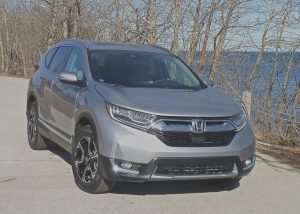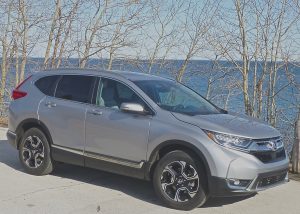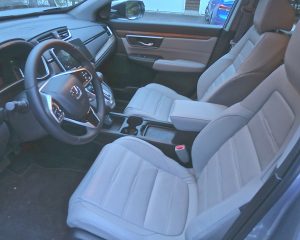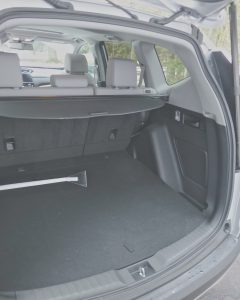CR-V adds turbo power to stay on top
By John Gilbert
If you know folks who own a Honda CR-V, chances are they love it. And, chances are it might be four or five years old, or older, and they still love it.
The CR-V has been an enduring vehicle for Honda, helping establish the trend toward compact SUVs, which proved immensely popular when gasoline was expensive, and have continued their upsurge in popularity even when gasoline became cheap.
With the new 2017 CR-V, Honda has made so many changes that its left even popular auto magazines in the distance. Take Motor Trend, for example. That magazine runs annual editions that run little capsule descriptions of all the new cars, trucks, and SUVs. It is very helpful if you’re looking at buying a new vehicle, because it helps with the research and cuts down the usual comparison shopping chore.
That issue came out last October. In its capsules, it ran pieces on the all-new Ridgeline, the Pilot, the Odyssey van, the HR-V, and the CR-V. Under CR-V, it says: “The CR-V remains unchanged. All CR-Vs are powered by a 185 horsepower 2.4-liter inline-4…”
I got the chance to spend a week with a new 2017 CR-V, and it was remarkably peppy and handled extremely well, and it had quite a different look to it. Unchanged? I think it is greatly changed.
Believing Motor Trend, I didn’t bother to look under the hood for several days. The CR-V ran well, handling all weather conditions, and seemed to uphold the tradition of being a new halo vehicle for Honda. Finally, I raised the hood. Sure enough, there was no 2.4-liter engine in sight — instead, it was a 1.5-liter 4-cylinder, with a turbocharger hanging onto the engine.
Honda is not new to turbocharging, and in fact has some progressive engineers who have established breakthrough technology with some previous turbos on vehicles such as the Acura RD-X. And Honda has used turbos to extremes while fiddling at the highest echelon of motorsports, places such as the Indianapolis 500 and Formula 1.
Honda had resisted the temptation to add turbochargers to its mainstream production vehicles. Turbos take a stream of exhaust gases that are headed for the tailpipes, and instead channels the flow to spin a generator turbine wheel that, in turn, force-feeds a more potent airflow into the engine’s intake. That air sucks in more fuel, and the result is more power and more efficiency.
The new CR-V, changed quite dramatically, thank you, is also changed under the hood. Instead of a 2.4-liter that produces 185 horsepower, the comparatively tiny 1.5 develops a quite amazing 190 horsepower and 179 foot-pounds of torque, thanks to the turbo.
While it feels light and agile (because it is!), the CR-V also has improved fuel efficiency, up to EPA ratings of 26 miles per gallon city, and 32 mpg in highway driving. All the while feeling quicker and more agile.
Other more subtle tricks include a more aerodynamic shape amplified by an active-shutter grille, which closes at cruising speed, when cooling isn’t needed, to form a barrier against air streaming in.
Honda now has bracketed the CR-V with an all-new larger Pilot, which is a truly full-featured luxury SUV now, and a smaller and more basic HR-V, which I was slightly disappointed in, but only because I was accustomed to the CR-V and the high standards it had set and maintained.
The new CR-V comes in various forms, starting with the LX at a base price of just over $26,000; the EX starting at $26,695; the EX-L (meaning leather upholstery) starting at $29,000; and the Touring model, starting at $32,000. The base LX starts with a front-wheel drive version, which should handled even Duluth type winter driving without difficulty. But the available all-wheel drive is the trick answer, because it is a “real-time” system that transfers torque away from any wheel where any tendency to spin is detected by the sharp-witted computer.
Stressing its safety and creature-feature style, the CR-V has Honda Sensing, which includes a suite of items such as lane-keep assist, collision mitigation, and road-departing mitigation which use computer aided technology to alert you if you wander across a lane-dividing line without signaling, and can be set to gently prevent you from wandering across that lane line.
Honda also has added the trick first developed by Ford for its Escape, where you can walk up to the CR-V from behind, holding your sacks of groceries, and wave your foot under the rear bumper, causing the tailgate to unlatch and open. Very handy.
The interior of the CR-V is upgraded too, although I’d like to make a strong suggestion to Honda to be careful how they “improve” their controls and switchgear.
My favorite feature of all Hondas is that they tend to have ergonomically perfect instruments and controls, meaning that you reach for something and it’s there. Even if you’ve never been in the vehicle, the lights are right where you think they should be, same with the wipers.
In recent model changeovers, however, there seems to be the tendency to make some items a bit more complex. Don’t do that! The CR-V still has logical redundant switches on the steering wheel, and you can pretty well operate everything from there.
Otherwise, you can operate the audio system’s technical complexities via the large navigation screen, which includes touch-screen operation. Personally, I’m not a fan of touch-screens. Seems to me, after three or four days, you need some high-tech stuff to clean the fingerprints off the touch-screen.

Nothing has changed more than the grille on each CR-V generation, and this time the stylists got it right.
Especially if you’ve stopped by the Great Lakes! Candy Shop in Knife River, and got overly friendly with some of those home-made caramel things. Let’s see you try to make it all the way home without sampling some of the goodies, after which you need some high-test washer fluid to clean the touch-screen.
As for the prices of the CR-V stable, each model offers all the features of the previous model, plus some added stuff. So the prices go up commensurately and each level seems to be a relative bargain. And while the basic LX is in the mid-$20,000 range, the completely loaded Touring model might reach the mid-$30,000 level. My favorite is the EX-L, because I like leather seats, and I’d pay extra for them, as well as the other features that model adds.
And so as not to embarrass anyone at Motor Trend, we’ll keep it a secret as we jump at that 1.5-liter turbo with its CVT, accepting power increases over the 2.4, as well as delivering fuel economy of over 30 mpg on the highway.







 John Gilbert is a lifetime Minnesotan and career journalist, specializing in cars and sports during and since spending 30 years at the Minneapolis Tribune, now the Star Tribune. More recently, he has continued translating the high-tech world of autos and sharing his passionate insights as a freelance writer/photographer/broadcaster. A member of the prestigious North American Car and Truck of the Year jury since 1993. John can be heard Monday-Friday from 9-11am on 610 KDAL(www.kdal610.com) on the "John Gilbert Show," and writes a column in the Duluth Reader.
John Gilbert is a lifetime Minnesotan and career journalist, specializing in cars and sports during and since spending 30 years at the Minneapolis Tribune, now the Star Tribune. More recently, he has continued translating the high-tech world of autos and sharing his passionate insights as a freelance writer/photographer/broadcaster. A member of the prestigious North American Car and Truck of the Year jury since 1993. John can be heard Monday-Friday from 9-11am on 610 KDAL(www.kdal610.com) on the "John Gilbert Show," and writes a column in the Duluth Reader.